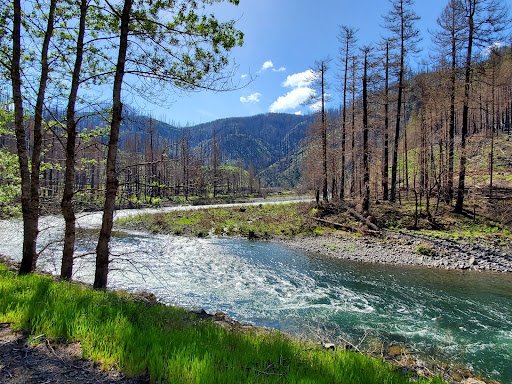Oct. 2023 Science Corner | Building water resilience in the face of cascading wildfire risks


Healthy, resilient forests provide a multitude of benefits for ecosystems and communities, with water supply protection and stewardship at the forefront. With many forested headwaters in the Western U.S. facing high risk of severe wildfire, water resources are also threatened.
Paper Authors: Megan Belongia, Courtney Hammond Wagner, Kimberly Quesnel Seipp, Newsha K. Ajami
Science Corner by: Kim Seipp, PhD
Healthy, resilient forests provide a multitude of benefits for ecosystems and communities, with water supply protection and stewardship at the forefront. With many forested headwaters in the Western U.S. facing high risk of severe wildfire, water resources are also threatened.
Evidence of catastrophic wildfire impacts to water supply systems has been increasingly clear in recent years. In California, the 2017 Tubbs Fire and 2018 Camp Fire led to drinking water contamination related to water impacts from and to the water distribution networks in communities impacted by the fires. In Colorado, even more than a decade after the 2002 Hayman Fire, the water quality impacts from the fire are still persisting, presenting drinking water treatment challenges. Wildfires are now impacting every aspect of our water supply systems including water quality and quantity in the headwaters; storage, conveyance, and distribution networks; and water treatment systems.
Research into these impacts and possible responses has grown substantially in recent years, but our understanding of wildfire-water interactions is still incomplete and ever-changing. Thus, a team of coauthors including Megan Belognia, Courtney Hammond Wagner, Blue Forest’s Managing Director of Science and Research Kim Seipp, and Blue Forest Board Member Newsha Ajami set out to synthesize the current state of knowledge, identify research gaps, and suggest areas for future research.
The result is a new paper published in Science Advances where the team reviewed over 200 papers and reports focusing on the nexus of wildfires and water. The review was structured to investigate wildfire impacts on three aspects of water supply systems: water quality, water quantity, and water infrastructure.
The authors first found that most research to date has focused largely on water quality and quantity, with substantially less focus on how wildfires impact water infrastructure. This finding identifies a critical knowledge gap, as infrastructure is necessary for delivering water supply, treating water to appropriate health standards, and protecting communities from water-related threats like flooding. Infrastructure can be affected by wildfires directly–for example, melting plastic pipes–or indirectly–for example, as degraded water post-fire carries sediment that can build up behind a dam. These infrastructure vulnerabilities can, in turn, create bottlenecks that constrain water availability and access. This research gap highlights a need for studies that focus on how fires in developed areas, particularly the Wildland Urban Interface, impact water systems.
Climate change is also compounding wildfire impacts, continually altering and threatening our water systems. Two examples of these cascading hazards include elevated drought occurrences that can coincide with severe wildfires, and more frequent and intense precipitation events that threaten post-fire landscapes lacking soil stability, leading to degraded water resources and infrastructure threats.
“The impacts of wildfires on water systems and water bodies are often sidelined or overlooked. However, it’s after the fires have been contained and the smoke has dissipated that this gradual and persistent challenge starts to surface,” stated Blue Forest board member and senior author of the paper, Newsha Ajami. “The good news is that there are actions that can be taken to both mitigate impact and increase the adaptive capacity of our water systems.”
These actions to create more resilient water supply systems include land use planning and management decisions both before and after a severe wildfire occurs. Forest management, including fuels reduction and thinning, is one of the most important measures that can be taken to decrease system vulnerability to wildfire. Other critical actions include updating building codes, developing land use policies, and including wildfire risk in water management plans. Actions that can increase the resilience of a water system when a fire does occur include improved predictive warning systems, water infrastructure redundancies, and flexible water sourcing. By taking these steps, utilities and communities can substantially mitigate wildfire risk and exposure and enhance recovery for water supply access and availability.
While the review showcases the large and growing volume of existing research, it also highlights gaps in our current understanding of the complex relationships between water supply and wildfire. For example, most studies so far have been focused on assessing post-fire outcomes for fire-affected water systems instead of modeling the upfront risk for these systems. This is largely because there is a limited understanding of the mechanisms controlling the interactions between wildfires and water supply systems, including how these interactions can change with forest management and other mitigating actions. This lack of understanding about the driving processes hampers our ability to reduce risk through optimized various management strategies and to forecast potential wildfire-induced water quality impacts. Other gaps identified by the authors include a need for better baseline data of pre-fire conditions, consistent metrics (e.g., burn severity in addition to area burnt), focusing on both the WUI and the headwaters, and supporting greater collaboration between land and water managers.
At Blue Forest, protecting water resources through accelerated and widespread forest management is a cornerstone of our mission. And we are grateful to the many water utilities we are partnering with in this endeavor! The Yuba I and Yuba II Forest Resilience Bond projects would not have been possible without the participation ofYuba Water and their commitment to protect their headwaters. And looking ahead, we are thrilled that many of our Forest Resilience Bond projects in the pipeline are being developed in partnership with water agencies interested in the many water benefits of forest management.